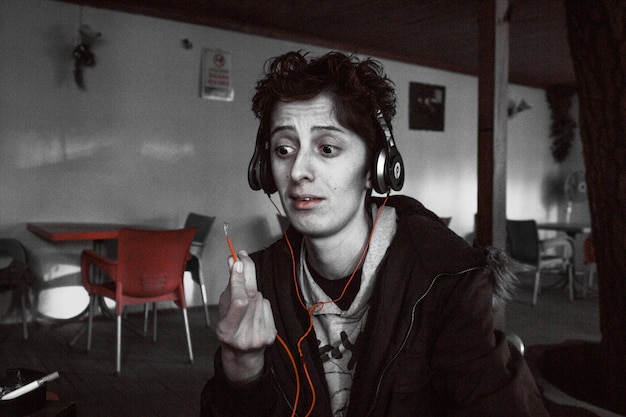True Crime Obsession: Unpacking America’s Fascination with the Genre

True crime fascination in the U.S. stems from a mix of psychological factors, including the thrill of danger, the puzzle-solving aspect of investigations, and the emotional connection to victims’ stories, all amplified by media portrayal.
The true crime obsession gripping America isn’t just a fleeting trend; it’s a deep-seated fascination with the darker side of human nature. From podcasts to documentaries, Americans are consuming true crime content at an unprecedented rate, leaving many to wonder: what’s the root of this intrigue?
Why Are Americans Hooked on True Crime?
True crime has exploded in popularity, dominating podcasts, streaming services, and bookshelves. But why are so many Americans drawn to stories of murder, mystery, and the macabre? Understanding this fascination requires a look at a blend of psychological, sociological, and cultural factors.
The Allure of the Dark Side
Humans have always been captivated by stories of darkness and deviance. True crime offers a safe way to explore these forbidden themes without experiencing the real danger. It’s a form of vicarious thrill-seeking, allowing us to confront our fears in a controlled environment.
The Appeal of the Puzzle
Many true crime narratives are structured like intricate puzzles, inviting viewers and listeners to piece together clues and solve the mystery alongside investigators. This interactive element can be incredibly engaging, providing a sense of intellectual stimulation and accomplishment.

- Psychological Distance: True crime stories, while disturbing, often involve events that feel distant from our own lives, creating a sense of safety and detachment.
- Cathartic Release: Engaging with true crime can provide a cathartic release, allowing us to confront and process our own fears and anxieties about crime and violence.
- Moral Exploration: True crime narratives often raise complex moral questions, prompting us to consider the nature of good and evil, justice and punishment.
In conclusion, the appeal of true crime is multifaceted, tapping into our primal fascination with the dark side, our desire to solve mysteries, and our need to understand the complexities of human behavior. It’s a genre that offers both entertainment and a strange sense of comfort in knowing that justice, however imperfect, can prevail.
The Psychological Underpinnings of True Crime Obsession
Delving deeper into the psychological aspects, it’s clear that several cognitive biases and emotional responses play a role in fueling the true crime phenomenon. These psychological underpinnings offer a framework for understanding why so many people are drawn to these narratives.
The “Just-World” Belief
Many people hold a “just-world” belief, the assumption that the world is inherently fair and that people get what they deserve. True crime stories can challenge this belief, forcing us to confront the reality that bad things can happen to good people. This can be both unsettling and strangely compelling.
Empathy and Identification
While true crime often focuses on the perpetrators of heinous acts, it also shines a light on the victims and their families. Many viewers and listeners feel a sense of empathy and identification with these individuals, leading to a desire to understand the circumstances surrounding their victimization.

- The Bystander Effect: True crime stories often explore the bystander effect, the phenomenon where people are less likely to intervene in a situation when others are present. This can prompt reflection on our own potential responses in similar scenarios.
- The Power of Narrative: True crime narratives are often carefully constructed to elicit specific emotional responses, from fear and anxiety to anger and outrage. This manipulation of emotions can be highly addictive.
- The Illusion of Control: By engaging with true crime, we may feel a sense of control over our own safety and security. We might believe that by learning about the methods and motivations of criminals, we can somehow protect ourselves from becoming victims.
In summary, the psychological drivers behind true crime obsession are complex and varied, encompassing our need to believe in a just world, our capacity for empathy, and our desire to feel safe and in control. These factors, combined with the compelling narratives that define the genre, contribute to its enduring appeal.
The Role of Media in Shaping True Crime Interest
The media plays a crucial role in shaping public perception and interest in true crime. Through various platforms, from television to podcasts, media outlets have amplified the genre and contributed to its growing popularity. Understanding this influence is essential for a complete picture of the true crime phenomenon.
Sensationalism and Exploitation
Some critics argue that true crime media often sensationalizes and exploits tragic events for entertainment purposes. The focus on graphic details and dramatic reenactments can be seen as disrespectful to the victims and their families.
The Rise of the Podcast
The podcast format has been particularly successful in the true crime genre. The serialized nature of many true crime podcasts allows for in-depth exploration of complex cases, while the intimate listening experience fosters a sense of connection between the host and the audience.
In conclusion, the media’s role in shaping true crime interest is undeniable. While the genre can provide valuable insights and raise important questions, it’s important to be mindful of the potential for sensationalism and exploitation. Critical engagement with true crime media is essential for understanding its impact on individuals and society.
Female Audiences and True Crime: A Unique Connection
Studies have shown that women make up a significant portion of the true crime audience. This demographic trend has prompted much discussion about the reasons behind women’s particular interest in the genre. Exploring this unique connection reveals some compelling insights.
Empowerment and Self-Defense
Some suggest that women are drawn to true crime as a form of empowerment and self-defense. By learning about the tactics and motivations of criminals, women may feel better equipped to protect themselves and their loved ones.
Social and Cultural Factors
Social and cultural factors may also play a role in women’s interest in true crime. Women are often socialized to be caregivers and protectors, which may lead them to feel a greater sense of responsibility for preventing crime and violence.
- The “Missing White Woman Syndrome”: The disproportionate media attention given to missing white women has been criticized for perpetuating racial biases and neglecting the stories of women of color.
- The Importance of Representation: There is a growing demand for more diverse and inclusive true crime narratives that reflect the experiences of all victims and communities.
- Ethical Considerations: As true crime continues to evolve, it’s important to consider the ethical implications of the genre, particularly in relation to the rights and privacy of victims and their families.
In summary, the connection between female audiences and true crime is complex and multifaceted, encompassing issues of empowerment, social awareness, and the enduring quest for justice. Understanding this dynamic is essential for a nuanced perspective on the true crime phenomenon.
The Ethical Considerations of True Crime Entertainment
As true crime continues to gain popularity, it’s crucial to consider the ethical implications of consuming and creating content that deals with real-life tragedies. Balancing entertainment with respect for victims and their families is a complex challenge.
Victim-Centered Storytelling
One approach to ethical true crime storytelling is to prioritize the experiences and perspectives of the victims and their families. This means avoiding sensationalism and focusing on the human cost of crime.
Avoiding Speculation and Conjecture
It’s also important to avoid speculation and conjecture, particularly when it comes to unsolved cases. Spreading misinformation or unsubstantiated theories can be harmful to the investigation and to the victims’ families.
- The Impact on Mental Health: Studies have shown that excessive consumption of true crime can lead to increased anxiety, fear, and paranoia.
- The Desensitization Effect: Some worry that exposure to violence through true crime media can desensitize individuals to the suffering of others.
- The Perpetuation of Stereotypes: True crime narratives can sometimes perpetuate harmful stereotypes about certain groups or communities, leading to prejudice and discrimination.
In conclusion, the ethical considerations of true crime entertainment are paramount. By prioritizing victim-centered storytelling, avoiding speculation, and being mindful of the potential impact on mental health and social biases, we can engage with the genre in a responsible and meaningful way.
The Future of True Crime: Trends and Transformations
The true crime genre is constantly evolving, adapting to new technologies and audience preferences. Understanding these trends and transformations is essential for anticipating the future of true crime entertainment.
Interactive and Immersive Experiences
One emerging trend is the rise of interactive and immersive true crime experiences, such as virtual reality simulations and augmented reality games. These technologies allow audiences to engage with the genre in entirely new ways.
Citizen Sleuths and Online Communities
The internet has also fostered the growth of online communities dedicated to solving cold cases. Citizen sleuths are using social media and online forums to share information, analyze evidence, and generate new leads.
In summary, the future of true crime is likely to be shaped by technological advancements, evolving ethical standards, and the enduring human fascination with the dark side. By embracing innovation and prioritizing responsible storytelling, the genre can continue to provide valuable insights and entertainment for years to come.
| Key Point | Brief Description |
|---|---|
| 🔍 Psychological Factors | Explores reasons why true crime attracts individuals. |
| 👩 Female Audience | Highlights the reasons for the strong interest of female audiences. |
| 📺 Role of Media | Discusses how media amplifies true crime’s popularity. |
| ⚖️ Ethical Concerns | Addresses ethical considerations in true crime storytelling. |
[FAQ Section]
Frequently Asked Questions
▼
True crime appeals to Americans due to a mix of psychological factors like the thrill of danger and puzzle-solving, plus cultural influences from extensive media coverage, creating a captivating genre.
▼
Yes, ethical considerations are crucial. It’s important to respect victims and their families by avoiding sensationalism and focusing on accurate, responsible storytelling that minimizes further harm.
▼
Women often engage with true crime as a form of empowerment, seeking knowledge about self-defense and understanding societal patterns of crime, alongside an interest in solving mysteries and understanding human behavior.
▼
Media has amplified true crime through various formats like TV shows and podcasts, creating widespread accessibility and sparking conversations, albeit with concerns about sensationalizing traumatic events.
▼
The future of true crime involves immersive experiences using VR and AR, citizen sleuthing online, and a focus on ethical, victim-centered narratives, adapting to technological advances and audience preferences.
Conclusion
The true crime obsession in America is a complex phenomenon, driven by a combination of psychological, sociological, and cultural factors. While the genre can be both entertaining and informative, it’s important to approach it with a critical eye, being mindful of the ethical considerations and potential impact on mental health and social biases.





